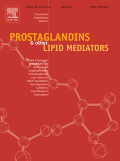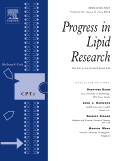
PROSTAGLANDINS & OTHER LIPID MEDIATORS
Scope & Guideline
Connecting Disciplines through Lipid Science
Introduction
Aims and Scopes
- Lipid Mediator Research:
The journal publishes research on lipid mediators such as prostaglandins, leukotrienes, and resolvins, exploring their biosynthesis, signaling pathways, and roles in various physiological and pathological processes. - Clinical Applications and Therapeutics:
Research articles often investigate the therapeutic potential of lipid mediators and their analogs in treating inflammatory diseases, cancer, and metabolic disorders. - Mechanisms of Inflammation and Resolution:
The focus includes understanding the mechanisms by which lipid mediators contribute to inflammation and the resolution of inflammation, with implications for chronic diseases. - Nutritional and Dietary Impacts:
The journal covers studies on the effects of dietary components, such as omega-3 fatty acids and antioxidants, on lipid mediator profiles and their physiological outcomes. - Innovative Research Methodologies:
Methodological advancements in lipidomics, including mass spectrometry and bioinformatics approaches, are highlighted to enhance the understanding of lipid mediators in biological systems.
Trending and Emerging
- Specialized Pro-resolving Mediators (SPMs):
There is an increasing focus on specialized pro-resolving mediators, which are crucial for resolving inflammation and promoting tissue repair, reflecting growing interest in their therapeutic potential. - Lipid Mediators in Neurological Disorders:
Research exploring the role of lipid mediators in neurological conditions, including Alzheimer’s disease and neuroinflammation, has gained momentum, emphasizing their significance in brain health. - Metabolic Disorders and Lipid Profiles:
Studies investigating the relationship between lipid mediators and metabolic disorders, such as obesity and diabetes, are trending, showcasing their role in metabolic regulation and potential interventions. - Bioinformatics and Lipidomics:
The use of bioinformatics tools and lipidomics technologies to analyze lipid mediators and their complex interactions is emerging, facilitating deeper insights into their biological roles. - Cancer and Lipid Mediators:
An uptick in research exploring the interactions between lipid mediators and cancer biology, particularly in tumor progression and treatment responses, indicates a growing intersection between oncology and lipid research.
Declining or Waning
- Traditional Herbal Remedies:
Research on traditional herbal remedies and their lipid mediatory effects has decreased, suggesting a waning interest in this area compared to more mechanistic studies. - Basic Biochemistry of Lipid Metabolism:
The foundational studies on lipid metabolism without direct implications for health or disease seem to be less frequent, reflecting a shift towards more applied research. - Non-specific Anti-inflammatory Agents:
Studies focusing solely on non-specific anti-inflammatory agents without linking them to lipid mediators or specific pathways have seen reduced publication, indicating a preference for more targeted approaches.
Similar Journals

BIOCHEMICAL AND BIOPHYSICAL RESEARCH COMMUNICATIONS
Exploring the molecular mechanisms that shape our world.BIOCHEMICAL AND BIOPHYSICAL RESEARCH COMMUNICATIONS, published by Academic Press Inc Elsevier Science, stands as a leading periodical in the fields of biochemistry, biophysics, cell biology, and molecular biology. With an ISSN of 0006-291X and an E-ISSN of 1090-2104, this esteemed journal has been a pivotal platform for the dissemination of groundbreaking research since its inception in 1959, continuing to publish influential findings through at least 2024. It holds a commendable Q2 ranking in Biochemistry and Q1 status in Biophysics as of 2023, reflecting its high impact and relevance in the field, supported by its strong Scopus rankings—ranking #43 in Biophysics and maintaining a presence in the top quartiles of several related categories. Although it is not an open-access journal, it provides critical insights and essential data that cater to researchers, professionals, and students keen on advancing their understanding of complex biochemical and biophysical processes. Its significant contributions to the scientific community underscore the importance of this journal as a reference point for innovative research and collaborative discourse.

International Journal of Biological Sciences
Unlocking the Secrets of Biological InnovationInternational Journal of Biological Sciences (ISSN: 1449-2288, E-ISSN: 1449-2288) is a premier open-access journal published by IVYSPRING INTERNATIONAL PUBLISHING since 2005, located in Australia. With a commitment to advancing knowledge in the life sciences, this journal covers a wide spectrum of disciplines, including Applied Microbiology and Biotechnology, Cell Biology, Developmental Biology, Ecology, Evolution, Behavior and Systematics, and Molecular Biology, earning a distinguished Q1 ranking in these fields as of 2023. It stands out with exceptional Scopus rankings, placing in the top ranks across multiple categories, such as the 98th percentile in Ecology, Evolution, Behavior and Systematics and the 94th percentile in Applied Microbiology and Biotechnology. The journal fosters an open access philosophy, ensuring that research findings are readily available to the scientific community and the public, and invites original research articles, reviews, and commentaries. With its mission to disseminate high-quality research, the International Journal of Biological Sciences serves as an essential resource for researchers, professionals, and students seeking to deepen their understanding and drive innovation in biological sciences.

PROGRESS IN LIPID RESEARCH
Connecting Research and Health Through LipidsProgress in Lipid Research, published by Pergamon-Elsevier Science Ltd, is a leading scientific journal dedicated to advancing the understanding of lipid biology and its implications for human health. With an impressive impact factor, it ranks in the Q1 quartile in both Biochemistry and Cell Biology as of 2023, reflecting its vital role in disseminating high-quality research. Covering a wide scope of topics from lipid metabolism to cell signaling pathways, the journal serves as a key resource for researchers, professionals, and students alike, striving to elucidate the complex functions of lipids in various biological systems. With publication converging since 1978 and extending to 2024, Progress in Lipid Research continues to provide innovative insights and foster collaboration within the scientific community, solidifying its reputation as an essential platform for lipid research.

Molecular Metabolism
Catalyzing Knowledge in Cell and Molecular BiologyMolecular Metabolism is a premier, open-access journal published by Elsevier, dedicated to advancing the understanding of metabolic processes at the molecular level. With an ISSN of 2212-8778 and a proud presence in Germany, the journal has made significant contributions to the fields of Cell Biology and Molecular Biology, consistently achieving a Q1 ranking in both categories as of 2023. The journal’s scope encompasses cutting-edge research that explores metabolic pathways, their regulation, and implications for human health, underscoring the interplay between metabolism and various biological functions. Researchers and professionals benefit from the journal’s robust visibility, as it ranks #40 among 410 journals in Molecular Biology and #35 among 285 in Cell Biology according to Scopus metrics, placing it in the top 10 percentile in its field. With open access since 2012, Molecular Metabolism ensures that groundbreaking research is available to all, fostering a collaborative and inclusive academic environment. Its commitment to excellence and accessibility makes it an invaluable resource for those invested in metabolic research.

CELL BIOCHEMISTRY AND FUNCTION
Advancing the Frontiers of Cell BiochemistryCELL BIOCHEMISTRY AND FUNCTION is a prominent journal dedicated to disseminating high-quality research in the fields of biochemistry, cell biology, and clinical biochemistry. Published by Wiley, this journal has maintained an esteemed reputation since its inception in 1983, bridging decades of scientific advancements and contributions until 2024. With ISSN 0263-6484 and E-ISSN 1099-0844, it serves as a vital resource for researchers, professionals, and students. The journal is classified in quartiles Q2 and Q3 across various categories in the 2023 rankings, showcasing its impact and significance within the academic community. Highlighting essential studies in medicinal biochemistry and cellular functionalities, CELL BIOCHEMISTRY AND FUNCTION not only presents cutting-edge research but also encourages interdisciplinary collaboration, thereby advancing the understanding of biochemical processes that underlie living systems. With no open access currently available, readers are encouraged to access articles through institutional subscriptions or individual purchases, ensuring exclusive engagement with the latest scientific findings in this dynamic field.

Journal of Inflammation-London
Bridging Basic Science and Clinical Insights on InflammationJournal of Inflammation-London, published by BMC, is a premier open access journal dedicated to advancing the understanding of inflammation, a critical process underlying numerous diseases including autoimmune disorders, cancer, and cardiovascular conditions. With its inception in 2004, the journal has consistently delivered high-quality research that bridges basic science and clinical applications, maintaining a significant place in the academic community. It holds impressive rankings within the Q2 category for both Cell Biology and Clinical Biochemistry, reflecting its impactful contributions to these fields, where it ranks in the 73rd and 64th percentiles respectively. The journal is committed to open access principles, ensuring that all published articles are freely available to researchers, practitioners, and the global community, thereby fostering collaboration and innovation. Located in the United Kingdom, the journal continues to attract submissions from prominent researchers and institutions worldwide, solidifying its status as an essential resource for the latest developments in inflammation research.

MOLECULAR MEDICINE
Elevating the Standards of Peer-Reviewed ScienceMOLECULAR MEDICINE, published by SPRINGER, is a leading scholarly journal dedicated to advancing the fields of genetics and molecular biology with a focus on clinical applications. Since its inception in 1994, it has evolved to become a pivotal platform for disseminating innovative research findings, achieving a remarkable Q1 ranking in multiple categories, including Genetics, Molecular Biology, and Molecular Medicine as of 2023. Featuring an Open Access model since 2000, the journal ensures that cutting-edge research is freely available to the global scientific community, facilitating collaboration and knowledge exchange. With a commitment to high-quality peer-reviewed content, MOLECULAR MEDICINE serves as an essential resource for researchers, healthcare professionals, and students seeking to stay at the forefront of molecular research and its implications for medical science. For those interested in contributing to or accessing vital research in this dynamic field, MOLECULAR MEDICINE stands out as a premier choice.

FREE RADICAL RESEARCH
Unveiling the Secrets of Oxidative MechanismsFREE RADICAL RESEARCH, published by TAYLOR & FRANCIS LTD, stands at the forefront of studies in biochemistry and medicine, with a distinguished trajectory since its inception in 1985. This esteemed journal, which boasts an ISSN of 1071-5762 and an E-ISSN of 1029-2470, is recognized for its impactful contributions within the scientific community, as evidenced by its Q2 ranking in the 2023 category quartiles for both Biochemistry and miscellaneous Medicine. Utilizing rigorous peer-review standards, FREE RADICAL RESEARCH disseminates critical findings on the role of free radicals in biological systems, facilitating knowledge exchange among researchers, healthcare professionals, and students. Although it is not an open-access journal, its reach through academic databases ensures visibility and accessibility of groundbreaking research, making it an indispensable resource for those engaged in the dynamic fields of biochemistry and molecular biology. As the journal continues to evolve until 2024, it remains committed to advancing our understanding of oxidative stress and its implications for health and disease.

Antioxidants
Unlocking the secrets of oxidative stress mitigation.Antioxidants is a premier open-access journal published by MDPI that has been actively contributing to the field of antioxidant research since its inception in 2012. Based in Switzerland, the journal holds a noteworthy impact factor indicative of its scholarly influence, particularly given its high rankings in various categories. As of 2023, it proudly sits in the Q1 quartile in Biochemistry, Clinical Biochemistry, Food Science, and Physiology, solidifying its status as a critical resource for innovative studies. With a strong focus on the roles of antioxidants across multiple disciplines—ranging from molecular biology to food science—this journal serves as a vital platform for researchers, professionals, and students aiming to advance knowledge in mitigating oxidative stress and enhancing health through dietary and therapeutic approaches. The open-access model guarantees wide accessibility, allowing for the dissemination of significant research findings globally, making it indispensable for anyone engaged in modern biochemical and physiological studies.

LIPIDS is a renowned peer-reviewed journal published by Wiley, dedicated to the field of lipid research, encompassing biochemistry, molecular biology, and organic chemistry. With its roots dating back to 1966 and a commitment to advancing knowledge until 2024, this journal serves as a vital platform for sharing significant findings in lipid biochemistry and its applications in health and disease. Although it currently does not offer Open Access options, it maintains a respectable standing with a Q3 ranking in Biochemistry and Organic Chemistry, and a Q4 ranking in Cell Biology based on the 2023 category quartiles. Additionally, its Scopus rankings reflect a solid position within the organic chemistry and biochemistry subfields. Published from Germany, LIPIDS caters to researchers, professionals, and students eager to explore the roles of lipids in biological processes and innovatory applications in various scientific disciplines.